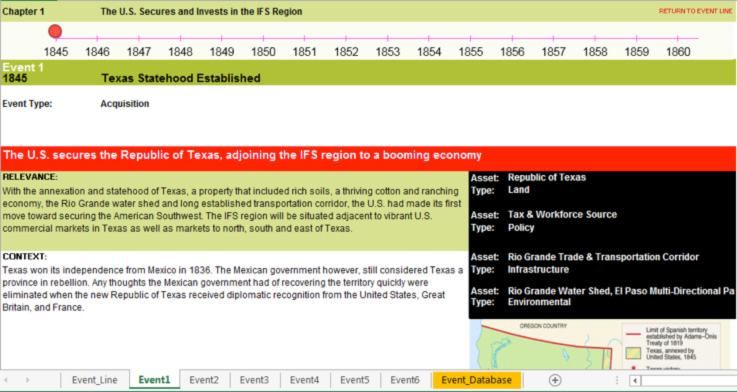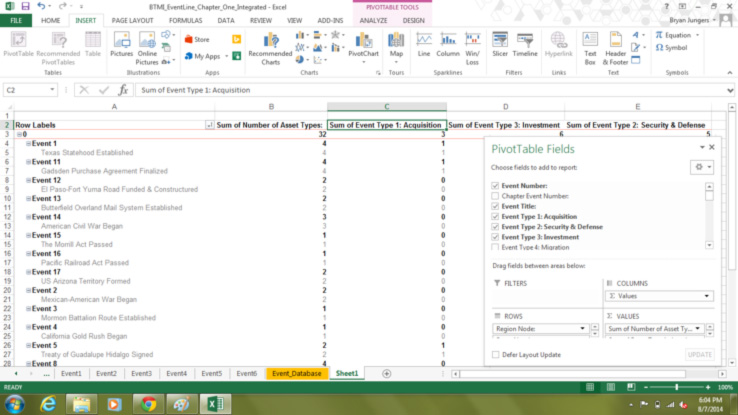WestWordVision has created a new relational database for the Event Line as part of the Genis Factor® methodology. The Event Line maps significant events that have shaped organizations and regions, turning historical narrative into science by showing the connectedness of events and their combined impact on the future. Now the Event Line is available to our clients in database format.
The prototype was developed with SpireWirk, a regional development consultancy, as part of a supply chain profile and asset inventory for Innovation Frontier Southwest, an economic and cultural region that spans from Yuma, Arizona to Las Cruces, New Mexico. The Event line traced the birth and evolution of the region’s security and defense industry, complementing SpireWirk’s research by providing a context from 1845 through today.
Our first task was to identify specific events that most significantly shaped the region’s security and defense industry. We identified 115 events and organized them into six chapters.
Each event was then put into historical context through identification of other concurrent social, political, economic and environmental factors.
Next, we extrapolated the relevance of the event, its impact on the region, the industry and/or other systems. Finally, we examined what historical assets each of the key events yielded.
This information was captured in the database narrative, delivering the region’s historical context in a scientific manner.
Once we placed an event into its context and identified its relevance using historic evidence, we were able to record the specific security and defense assets that were yielded for the region.
The database narrative can be examined as an interconnected chain of events (red bar below is the event chain) through time. In this way, we can see how the events have shaped and impacted the region.
Database queries can search events and assets by temporal and/or spatial data. Patterns through time can be seen, and future opportunities can be identified.
As an example, all migration events (an event that causes or responds to a major human migration) can be interpreted in relationship to each other. Or for a more complete view, all migration events can be interpreted with all transition events. The use of multiple event threads creates thematic clusters which provide a deeper and more detailed understanding of the impact historical events have had on the region.
The database narrative can also be used to compare various events in case studies. For example, we contrasted the progress of one small community formed around a prominent military base with the progress of another large community whose economy had transitioned with the arrival of a large security and defense company. How did each community fare? What can we learn from the patterns? We can make informed decisions for the future by using this data.
The Event Line taps into a region’s inheritance by offering the wisdom of hindsight. We are able to place major events in context, record their impact, identify untapped assets accumulated through time and leverage those assets. We’ve used this wisdom to build authentic brands, construct powerful narratives, archive institutional knowledge, develop leadership strategies, roll out important agendas and inspire collaboration.
The Event Line provides regions and organizations with a cause-and-effect tool for strategic action. Once regions and organizations achieve these new perspectives, they can use more of their inherent wealth.
New perspectives, which we call 360-degree intelligence, include:
- Past-present-future connections
- Micro-macro contrasts
- Cross-silo influences
- Large-scale patterns and opportunities
We are now offering a free demonstration of the database narrative. If you are interested in scheduling a presentation for your organization or group, please call Paula Schaper at 520-394-2575.
Learn more about the Genis Factor® method.



